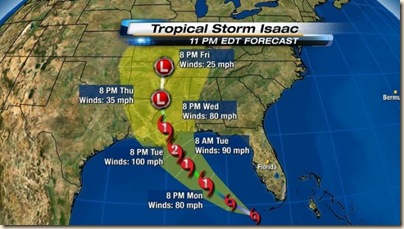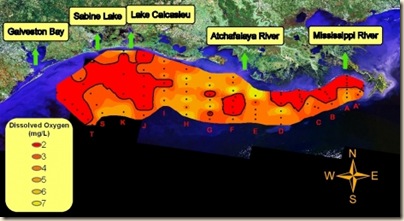Friday, August 31, 2012
Thursday, August 30, 2012
Swarm
It has been almost a year since I predicted a major earthquake would hit California in the near future -http://boggythicket.blogspot.com/2011/09/earthquake-prediction.html – and no, it hasn't happened yet.
This week, though, Southern California has experienced an "earthquake swarm” – something I didn’t know existed.
More than 400 earthquakes greater than magnitude 1.0 have been recorded in Imperial County since Saturday evening, said U.S. Geological Survey geophysicist Elizabeth Cochran. The largest were a 5.3 and a 5.5 about midday Sunday.
Scientists say the reason is not fully understood, but there is a clue: Earthquake faults work much differently south of the Salton Sea than they do closer to Los Angeles.
Take, for instance, the San Andreas fault as it runs through Los Angeles County. It’s a fault where, generally speaking, two plates of the Earth’s crust are grinding past each other. The Pacific plate is moving to the northwest, while the North American plate is pushing to the southeast.
South of the Salton Sea, the fault dynamic changes. The Pacific and North American plates start to pull away from each other, Cochran told The Times from her Pasadena office. (That movement is what created the Gulf of California, which separates Baja California from the rest of Mexico.)
So Imperial County is caught between these two types of faults in what is called the Brawley Seismic Zone, which can lead to an earthquake swarm, Cochran said.
The last major swarm was in 2005, Cochran said, when the largest magnitude was a 5.1. The largest swarm before last weekend's occurred in 1981, when the biggest quake topped out at 5.8. Before that, there were swarms in the 1960s and 1970s.
The Imperial County Board of Supervisors declared the emergency after getting more information about damage. According to the Imperial Valley Press, 19 mobile homes have been red-tagged, several buildings -- including a school auditorium -- have been closed because of damage and water pipes broke. There has been no total damage estimate.
Most of the damage has been cosmetic, and of course a lot of stuff fell off of shelves.
Wednesday, August 29, 2012
the Great Facebook Experiment
My politics, like my religious beliefs (or lack thereof) are pretty hard to pigeonhole. I guess I'm closer to being a Libertarian than any other label currently in use, but I’m not a perfect fit. I’m a fiscal conservative and a human-rights liberal, but there are exceptions in both categories.
I think the spokesmen on both the far left and the far right are a bunch of charlatans and fools, but I do find that even the most outrageous buffoons at either end of the spectrum do occasionally get something right.
Currently, my big complaint is the lack of civility in politics. I have a Facebook friend who posts dozens of truly offensive articles daily from some of the most blatant of the far left blogs – articles designed to inflame, full of lies and/or carefully edited half-truths.
I was getting so tired of these tirades that I was considering “unfriending” this person, then today I discovered this option:
My Facebook page is Much more pleasant now.
Tuesday, August 28, 2012
Waterfalls and Rainbows
Came across this photo on the net, and liked it too much not to share. It was taken somewhere in South America by Ben Steinberger, and features two of my favorite things – waterfalls and rainbows.
Monday, August 27, 2012
Hurricane or Earthquake
It’s been almost a year since I predicted a major quake would hit California soon. So far, there have been a lot of piddley little tremors – quakes that would be news in Houston, but ignored in LA – but nothing that could be called major.
Today, it looks like New Orleans will get another hurricane before California gets an earthquake.
Residents in unprotected, low-lying areas outside New Orleans were evacuating Monday as Tropical Storm Isaac threatened to strengthen into a hurricane that could make landfall in or near Louisiana almost seven years to the day that Hurricane Katrina struck.
It's "trying to form an eye-like feature" but it's "still a little bit shy of hurricane status," National Hurricane Center Director Rick Knabb said in a morning update.
At 65 mph, Isaac was just nine miles short of hurricane status and that should happen within the next 24 hours, Knabb added.
The governors of Alabama, Louisiana and Mississippi declared states of emergency as a hurricane warning went into effect for a roughly 300-mile stretch of the Gulf Coast in four states from Louisiana to the Florida Panhandle.
"Tonight is when the conditions will start to go downhill" ahead of landfall Tuesday night, Knabb said.
The National Hurricane Center was no longer forecasting a Category 2 hurricane on landfall, but instead a weaker Category 1. Still, Isaac will probably move slowly inland, possibly dumping as much as 18 inches of rain in places, Knabb said.
"That's going to be the big problem," NBC meteorologist Al Roker said on TODAY. "We're talking about potentially 24 hours of hurricane force winds and heavy rain."
Sunday, August 26, 2012
Dead Zone
This year’s severe drought, centered in the Midwest, cut runoff and nutrient loading into the Mississippi and the Gulf of Mexico, resulting in the smallest dead zone in the Gulf in several years.
Texas A&M Oceanography professor Steve DiMarco cruised more than 1,200 miles in the Gulf in mid-August to measure this year’s oxygen-starved area, finding that only about 1,500 square miles affected by hypoxia, mostly near the Mississippi River delta off the coast of Louisiana.
“We had to really hunt to find any hypoxia at all and Texas had none,” DiMarco said. “In all, we found about 1,580 square miles of hypoxia compared to about 3,400 square miles in August 2011. What has happened is that the drought has caused very little fresh-water runoff and nutrient load into the Gulf, and that means a smaller region for marine life to be impacted.”
Hypoxia is when oxygen levels in seawater drop to dangerously low levels, defined as concentrations less than 2 milligrams per liter, and persistent hypoxia can potentially result in fish kills and harm marine life, thereby creating a “dead zone” of life in that particular area.
A trend toward larger dead zones in recent years spurred concern for commercial and sport fisheries, as marine life either dies or moves away from the oxygen-starved waters.
This was the first time in several years that the size of the dead zone stayed below the target of 1,900 miles set by the Gulf of Mexico/Mississippi River Watershed Nutrient Task Force.
The average size of the dead zone between 2005 and 2010 was 6,653 square miles, and the 2011 dead zone, fueled by a record runoff, was larger yet. The task force has been working to reduce nutrient loading.
“Despite fluctuations in the size of the dead zone due to short-term weather events, the fact remains that we have a large and persistent area of severely degraded habitat that is caused by excessive nutrient pollution draining into the Gulf,” said Robert Magnien, Ph.D., director of NOAA’s Center for Sponsored Coastal Ocean Research.
DiMarco said the size of the dead zone off coastal Louisiana has been routinely monitored for about 25 years. Previous research has also shown that nitrogen levels in the Gulf related to human activities have tripled over the past 50 years.
During the past five years, the dead zone has averaged about 5,700 square miles and has reached as high as 9,400 square miles.
The Mississippi is the largest river in the United States, draining 40 percent of the land area of the country, including vast areas of chemically fertilized farmlands. The river accounts for almost 90 percent of the freshwater runoff into the Gulf of Mexico.
“These findings confirm what we found in a trip to the Gulf back in June, and also what other researchers in Louisiana have discovered, so there is general agreement that the dead zone this year is a very, very small one.
“The changes we see year to year are extreme. For example, last year, record flooding of the Mississippi River and westerly winds in the Gulf led to a much larger hypoxic area, particularly earlier in the summer. "
Saturday, August 25, 2012
Friday, August 24, 2012
Graph
I make no claim to be any sort of expert on Women’s Magazines, but I have read a few while sitting in waiting rooms at doctor’s offices, etc.
At some point, the graph below was probably correct, but it fails to consider the plethora of articles devoted to achieving multiple orgasm.
Thursday, August 23, 2012
Wednesday, August 22, 2012
(Nearly) Back to Normal
We spent our first night back in the house last night.
We still have a lot of cleaning/organizing to do, but at least we can see normal somewhere on the horizon.
Thinking about the last few weeks, I penned the following:
We recently had our home re-leveled
Because some of the walls became beveled
The drought caused a drift
Made the foundation shift
Our poor house was looking disheveled
We’ve been camping out in back
While contractors paint and patch cracks
The paint smell’s too strong
To stay in there long
So the trailer is where we hit the sack
We love our trailer when we’re on the road
40,000 miles it’s been towed
Oh, the trips on which we’ve gone
From Key West to Oregon
But it’s good to be back in our abode
Tuesday, August 21, 2012
Hot Stuff
Saw this picture on the net – a multitasking shopper was baking chocolate chip cookies on the dashboard of her car while shopping at WalMart.
I have never tried this, but on a recent trip I did manage to blow up a cigarette lighter.
I left the lighter on the console, and when I came back to the car after about an hour in the store, I found a few shards of plastic on the driver’s seat, and the remainder of the lighter in the back floorboard on the passenger side.
Just a couple of examples of how ungodly hot it can get in a car on a sunny day, and yet we still hear stories about people leaving children and pets in their vehicles.
Monday, August 20, 2012
Automotive A-C
I grew up in the air-conditioning business. My dad, upon returning from WW-II was hired by the first air conditioning company in the city of Houston, so I was very interested in an email I received this morning:
Did you know????
The Goldberg Brothers - Inventors of the Automobile Air Conditioner.
Here's a little factoid for automotive buffs or just to dazzle your friends..
The four Goldberg brothers, Lowell, Norman, Hiram, and Maxwell, invented and developed the first automobile air-conditioner.
On July 17, 1946, the temperature in Detroit was 97 degrees.
The four brothers walked into old man Henry Ford's office and sweet-talked his secretary into telling him that four gentlemen were there with the most exciting innovation in the auto industry since the
electric starter.
Henry was curious and invited them into his office.
They refused and instead asked that he come out to the parking lot to their car.
They persuaded him to get into the car, which was about 130 degrees, turned on the air conditioner, and cooled the car off immediately.
The old man got very excited and invited them back to the office, where he offered them $3 million for the patent.
The brothers refused, saying they would settle for $2 million, but they wanted the recognition by having a label, 'The Goldberg Air-Conditioner,' on the dashboard of each car in which it was installed.
Now old man Ford was more than just a little anti - Semitic, and there was no way he was going to put the Goldberg's name on two million Fords.
They haggled back and forth for about two hours and finally agreed on $4 million and that just their first names would be shown.
And so to this day, all Ford air conditioners show
-- Lo, Norm, Hi, and Max -- on the controls.
I can hear your groans from here. Control yourself!!! I was sucked in, too!
Friday, August 17, 2012
Arson Is Beginning To Make Sense
Still camped out in the back yard, but we are in the process of moving some of our stuff back into the house. We should be back in ourselves within the next day or two.
Everything we own has been moved at least twice, and most things multiple times, as we empty rooms for the painters. It’s actually harder than moving to a new house – at least, it involves more moves per item.
I think that if the house ever needs painting again, I’ll just burn it down.
I’m not contemplating insurance fraud - but before I would do this again, I would rather just burn it down, walk away, and start over entirely.
Sunday, August 12, 2012
Hard to Post from Hell
Day thirty two of the home remodeling project.
Actually, they only started last Monday; it just seems like it’s been going on forever. Except for a few touch-up items, the utility room, kitchen, dining room, hallway and den are done. They start on bedrooms tomorrow.
Meanwhile, we are moving furniture around, sorting and storing and throwing stuff away. Yesterday, I delivered nine 33-gallon trash bags full of clothes and bedding to Goodwill.
Still living in the camper in the back yard, and we will be until the end of next week. Hopefully, by then things will be back to what passes for normal around here.
Thursday, August 9, 2012
B’day Report
Managed to have a great birthday in spite of the turmoil at home. Slept in the trailer, had breakfast in the house and went out to dinner at one of our favorite restaurants.
All in all, a good day.
Wednesday, August 8, 2012
Thresholds
I could not wait until I turned five
Why, I’d be the happiest kid alive
Wait, six is better – when that is made
I’ll be old enough to attend first grade
Nothing much happened when I turned seven
Nine or ten, or even eleven
But if I just make it to thirteen
I’ll be a teenager – no longer a tween
Eighteen join the Army, carry a gun
Drink and vote at twenty-one
Thirty a real man, no longer a kid
They’ll take me serious – but nobody did
Black balloons at my birthday party
Over the hill when I turned forty
I might have retired at sixty-five
I didn’t, had to work to survive
Sixty-nine’s a good number, a very good year
But it’s going away in a few hours I fear
On the threshold of seventy- no longer a pup
Is this the year when I finally grow up?
Tuesday, August 7, 2012
Upside Down
Our house is Upside-Down!
Not literally, like the picture above, the house is still standing upright, but our lives are upside-down for the next several days.
It all began back in May when we had our house re-leveled - Leveling Blues – now we are having the walls and ceilings repaired and repainted. The crew began yesterday, and they will have most of the house unusable for about a week. We can still access the bedrooms and bathrooms, but everything else is either out of commission or sheathed in plastic so we can’t get to it.
I am writing this from our 5th wheel trailer in the back yard. Thank goodness we got it back from the shop.
Monday, August 6, 2012
Unhappy Farmer
A Vermont farmer who was arrested last month expressed his displeasure last Thursday afternoon in Newport by driving a heavy tractor over seven police vehicles owned by the Orleans County Sheriff’s Department. The weapon he used was
“It’s pretty much the biggest tractor you can get,” Newport City Police Chief Seth DiSanto said.
State police estimated the damage at about $250,000. No one was hurt.
Roger Pion, 34, is facing seven counts of felony unlawful mischief and one misdemeanor count of unlawful mischief on suspicion of damaging the cars, State Police Detective Trooper Lyle Decker said.
Decker said Pion also is facing charges of leaving the scene of an accident, grossly negligent operation and aggravated assault on Newport City police on allegations of trying to back the tractor into a city cruiser after fleeing the original scene.
“It’s more than half our fleet. We have 11 cars,” Chief Deputy Sheriff Phil Brooks told the Burlington Free Press. He said the cruisers were in three rows.
He said all the vehicles were insured. Brooks estimated that the cruisers averaged about $40,000 fully equipped. He said at least one cruiser had a laptop in it.
Brooks said five of the damaged vehicles were fully marked red, white and black cruisers, and two were unmarked, including a transport van. An eighth car, belonging to the department bookkeeper, was pushed out of the way by the tractor in an effort to get at the cruisers.
Sunday, August 5, 2012
Omnium
The headline from the London Olympics this morning said that Australia’s Glenn O’Shea is leading in the Omnium.
That’s nice…..
What the Hell is an Omnium?
An Omnium is a multiple race event in track cycling in which all contestants compete against each other in six different disciplines. The Omnium can be considered the event which determines the best all-round track cyclist as the disciplines feature both sprint events and endurance events – a sort of pentathlon plus one on wheels.
Omnium is also a Steel Alloy stronger than Titanium but weaker than Adamantium.
If Adamantium were an Olympic event, I’ll bet the leader would be a woman.
Saturday, August 4, 2012
Burn Baby, Burn
With a few caveats (like don’t use PABA on babies) medical authorities from the Center for Disease Control and Prevention and the National Institutes of Health recommend the use of sunscreen, especially for those with sensitive skin. The higher the SPF – sun protection factor – the better.
Just don’t let it happen at school.
The event that prompted this post actually occurred back in June. I would have mentioned it earlier, but I just came across the story yesterday.
Two little girls at a Tacoma school outing got burned to a crisp because state law in Washington – and every other state except (gasp) California – prohibits the use of sunscreen in public schools without a doctor’s prescription. Teachers can not apply it to students, and students carrying it to school are subject to expulsion.
You can read the mother’s account on her Blog.
While I can certainly understand the need for rules, incidents like this – and the almost constant flow of stories about remarkably stupid application and enforcement of Zero Tolerance policies – make me wonder if anyone in public education is even capable of rational thought.
What ever happened to flexibility and logic?
Friday, August 3, 2012
Just Call Me Crash
Yesterday, we learned that four teams – eight women – were disqualified and expelled from the Olympics for intentionally tanking Badminton matches. Today, we learn that if you intentionally crash in Cycling, it can lead to Gold.
Philip Hindes says that he deliberately crashed after making a poor start in the heats of the Olympic track cycling team sprint, an event in which he and fellow Britons Chris Hoy and Jason Kenny went on to win gold.
"We were saying if we have a bad start we need to crash to get a restart," Hindes was quoted by British newspapers as saying.
"I just crashed. I did it on purpose to get a restart... it was all planned really."
Hindes, who was starting for the Brits, seemed to have trouble with his front wheel and crashed after a quarter of a lap in the match against Germany.
After Britain were allowed to restart, in accordance with UCI rules, Hindes made a cannonball opening to perfectly launch Kenny with Hoy finishing off in style.
British Cycling said his comments were "lost in translation", adding the German-born rider only started to learn English in October 2010. The International Cycling Union (UCI) confirmed the result was not in question.
When you crash in a sprint, it is considered a false start, said French technical director Isabelle Gautheron. He added that Great Britain was the deserved winner but that the rules should be changed.
"The team sprint regulations should be changed. We need more clarity," Gautheron said. "But the best team won, they beat the world record twice, they deserved their victory. They played with the rules."
Thursday, August 2, 2012
Bad(minton) Day
Haven’t said much about the Olympics, although I have been watching almost four hours a day since that horrible opening ceremony. Like NBC, I have been appropriately jingoistic in cheering on American athletes while pretty much ignoring anyone else.
That changed yesterday with the Great Badminton Scandal, and I’ve been reading as much about it as I can find.
In case you missed it, eight of the world’s top women’s doubles players – one team each from China and Indonesia, and two teams from South Korea – were disqualified for tanking their matches.
The women involved have had their Olympic credentials revoked and are being evicted from the Olympic Village. One of them, Yu Yang of China, who is considered to be the best birdie basher in the world, has announced her retirement.
Today, the International Olympic Committee is asking the Chinese, South Korean and Indonesian national Olympic committees to investigate the coaches of the badminton players who were disqualified for trying to lose matches. IOC spokesman Mark Adams says “We have asked the NOCs to look into the entourage issue” to determine whether team coaches, trainers or officials should also be punished.
This all started when a Chinese team attempted to lose to a South Korean pair. A win would have pitted the Chinese against the other Chinese team in the elimination round, but a loss would have put them in position to win their bracket and play in the final – lose and play for Gold or Silver, win and the best the second place Chinese team could hope for was Bronze. It was the sort of strategic move that is rumored to happen often in sports with playoffs.
The Koreans were having no part of it, and in a second match, against Indonesia, the other Korean team tried to do the same thing.
The problem was that it was just so damn blatant. The best players in the world looked like they had never held a racquet before, and stumbled around the court to the boos of the fans. You can see how bad it was Here.
Wednesday, August 1, 2012
Bird Brains
This is a reprint of a recent article in SCIENCE. I found it fascinating; maybe you will, too:
Many children (and adults) have heard Aesop's fable about the crow and the pitcher. A thirsty crow comes across a pitcher partly filled with water but can't reach the water with his beak. So he keeps dropping pebbles into the pitcher until the water level rises high enough. A new study finds that both young children and members of the crow family are good at solving this problem, but children appear to learn it in a very different ways from birds.
Recent studies, particularly ones conducted by Nicola Clayton's experimental psychology group at the University of Cambridge in the United Kingdom have shown that members of the crow family are no birdbrains when it comes to cognitive abilities. They can make and use tools, plan for the future, and possibly even figure out what other birds are thinking, although that last claim is currently being debated. A few years ago, two members of Clayton's group showed that rooks can learn to drop stones into a water-filled tube to get at a worm floating on the surface. And last year, a team led by Clayton's graduate student Lucy Cheke reported similar experiments with Eurasian jays: Using three different experimental setups, Cheke and her colleagues found that the jays could solve the puzzle as long as the basic mechanism responsible for raising the water level was clear to the birds.
To explore how learning in children might differ from rooks, jays, and other members of the highly intelligent crow family, Cheke teamed up with a fellow Clayton lab member, psychologist Elsa Loissel, to try the same three experiments on local schoolchildren aged 4 to 10 years. Eighty children were recruited for the experiments, which took place at their school with the permission of their parents.
In all three experiments, instead of worms, the children tried to retrieve red tokens that they could exchange for colorful stickers depicting animals, pirates, and other images. (The team found that both younger and older children were keenly interested in having the stickers.)
In the first experiment, the children were presented with two tubes, one filled with water and the other with sawdust, and had to decide which one to drop marbles into to get a token from inside.
The second experiment featured just one tube filled with water, but the children had to choose between two different objects to put into it—a cork ball that floated, or a marble that sunk.
The third task was the toughest. Cheke and her co-workers presented the children with an apparatus with three different water-filled tubes: two wide ones on either side of a narrow tube, which held a token. The bottoms of the tubes were hidden, concealing the fact that one of the wide tubes was in fact connected at the bottom to the narrow center tube, whereas the other wide tube stood alone. And since the middle tube was too narrow to drop a marble into, the child could choose to put the marble into only one of the two wide tubes. The only way to get the token was to drop a marble into the wide tube connected to the narrow one. Thus in this third case, the apparatus worked in a way that was mysterious to the children.
The children were allowed five trials per experiment lasting 2 minutes each to learn the tasks. As might be expected, the older children did better than the younger children: By age 8, most children were able to successfully perform all three tasks during the first trial, and younger children required more trials, the researchers report today in PLoS ONE. But their performance contrasted in an important way with that of the birds. While the jays were able to learn the first two tasks by trial and error, they could not master the third experiment, in which the solution was not obvious and even counterintuitive.
Cheke and her colleagues conclude that this suggests a fundamentally different learning process between the birds and the children. Whereas the birds were put off by a seemingly physically impossible setup and couldn't learn the third task, children weren't stymied by the apparent impossibility of the task, but forged ahead and learned to raise the tokens anyway—even if it wasn't obvious how it was happening or the solution didn't seem to make intuitive sense.
"Children start off with no idea of what is possible and what is not possible," Cheke says. "If they did, they would never be able to learn. This is why children like magic, and why they will believe you when you tell them all kinds of fanciful things."
Alison Gopnik, an expert in child developmental psychology at the University of California, Berkeley, calls the study "fascinating and illuminating." The main difference between the birds and the children, Gopnik says, is that members of the crow family "have sophisticated but specific knowledge about how physical causal relationships work in the world," whereas children "seem to have broader and more wide-ranging causal learning abilities."
As a result, Gopnik adds, the birds "are beautifully adapted to learn about this world," but "children are beautifully adapted to learn about many possible worlds."

















